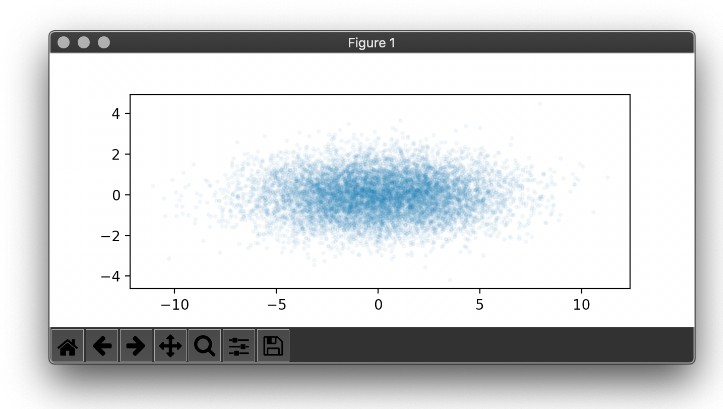ganttrify
ganttrify facilitates the creation of nice-looking Gantt charts, commonly used in project proposals and project management.
Motivation
It is possible to find online documented attempts at facilitating the
creation of Gantt charts from R. Some of them
(e.g. this
and this)
use ‘ggplot2’, but I feel they do not look very nice. The same goes for
the answers I found in the relevant Stackoverflow
question.
Even
Plotly
enables the creation of Gantt charts in R, but again, I don’t like the
end result.
I did find a solution that was rather visually
satisfying,
but it was in base R, and all the cool kids nowadays know that base
plotting in R exists only for compatibility with
S: not an option! (Hey, I’m joking,
don’t @ me!)
Given what is evidently my posh taste for Gantt charts, I had no other
option than making this package with a pretentious, gentrified name,
instead of the obvious “ganttr”.
Please welcome ganttrify.
Disclaimer
More seriously, this has been a quick attempt at making decent-looking
Gantt charts.
And yes, I will enable all the customisations you like, but first I
actually need to submit this project.
2020-05 update
As I’ve seen some people actually started using this package, I have
added some functionalities and significantly improved the shiny app. If
you have used an earlier version, you may need to adapt column names and
some parameter names to the new syntax, following the updated examples
(it should take just a few seconds).
Features
Take an adequately formatted spreadsheet and turn it into a Gantt chart
made with ggplot2.
Installation
You can install the development version from
GitHub with:
# install.packages("remotes")
remotes::install_github("giocomai/ganttrify")
Example
Here is an example project:
| wp | activity | start_date | end_date |
|---|---|---|---|
| WP1 - Whatever admin | 1.1. That admin activity | 1 | 6 |
| WP1 - Whatever admin | 1.2. Another admin activity | 3 | 6 |
| WP1 - Whatever admin | 1.3. Fancy admin activity | 4 | 7 |
| WP2 - Whatever actual work | 2.1. Actual stuff | 5 | 10 |
| WP2 - Whatever actual work | 2.2. Actual R&D stuff | 6 | 12 |
| WP2 - Whatever actual work | 2.3. Really real research | 9 | 12 |
| WP2 - Whatever actual work | 2.4. Ethics! | 3 | 5 |
| WP2 - Whatever actual work | 2.4. Ethics! | 8 | 9 |
| WP3 - Dissemination | 3.1. Disseminate near | 6 | 9 |
| WP3 - Dissemination | 3.1. Disseminate near | 12 | 12 |
| WP3 - Dissemination | 3.2. Disseminate far | 8 | 12 |
Month since the beginning of the project are used as reference in order
to make it easier to change the date when the project starts without
needing to change the timing of all activities.
If you prefer to include dates instead of month numbers, please see
additional examples below.
library("ganttrify")
ganttrify(project = ganttrify::test_project,
project_start_date = "2020-03",
font_family = "Roboto Condensed")
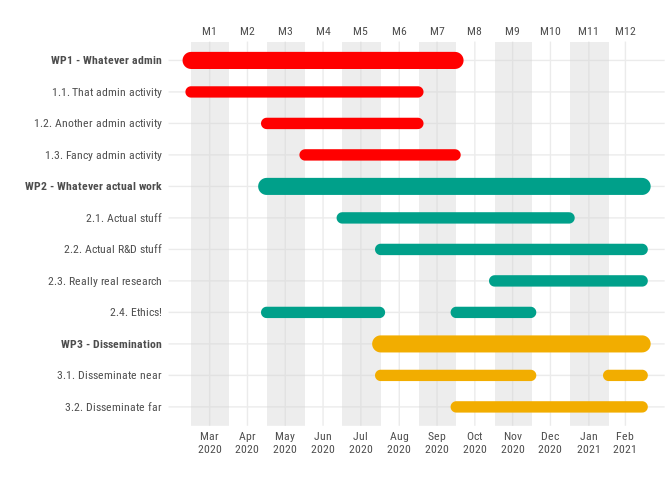
[all
examples in this page will use the Roboto condensed font; if it is not
installed, you can use the default sans. See the Troubleshooting
section at the bottom of this readme.]
“But what if I wanted to add spot labels for events, deliverables,
outputs, milestones, things like that?”, you asked.
Just put them in a table with these column names, and you will be
served.
| activity | spot_type | spot_date |
|---|---|---|
| 1.1. That admin activity | D | 5 |
| 1.3. Fancy admin activity | E | 7 |
| 2.2. Actual R&D stuff | O | 7 |
| 2.2. Actual R&D stuff | O | 9 |
| 2.2. Actual R&D stuff | O | 11 |
| WP2 - Whatever actual work | M | 6 |
ganttrify(project = ganttrify::test_project,
spots = ganttrify::test_spots,
project_start_date = "2020-03",
font_family = "Roboto Condensed")
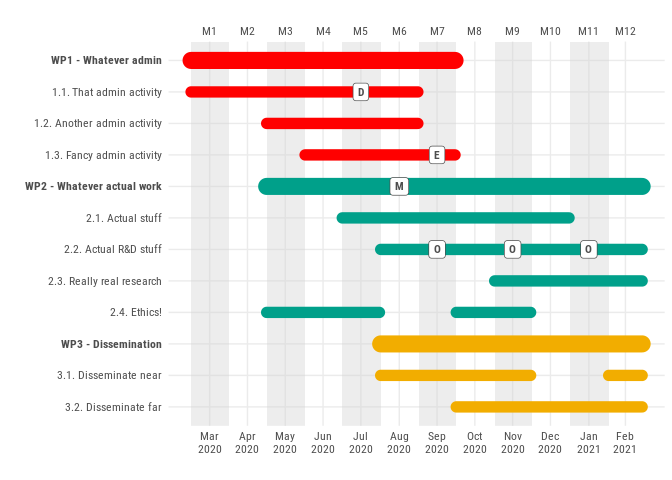
“I can’t read the text, can I change the text size?”, I heard. “Also, is
it possible to outline quarters?”
You’re welcome.
ganttrify(project = ganttrify::test_project,
spots = ganttrify::test_spots,
project_start_date = "2020-03",
size_text_relative = 1.2,
mark_quarters = TRUE,
font_family = "Roboto Condensed")
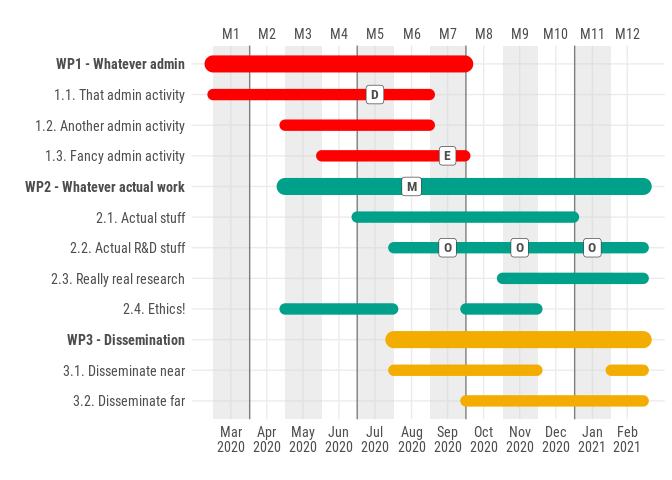
Shiny app
If you prefer interactive web interfaces to coding, you can still have a
fancy ganttrified chart.
shiny_ganttrify()
And there you go!
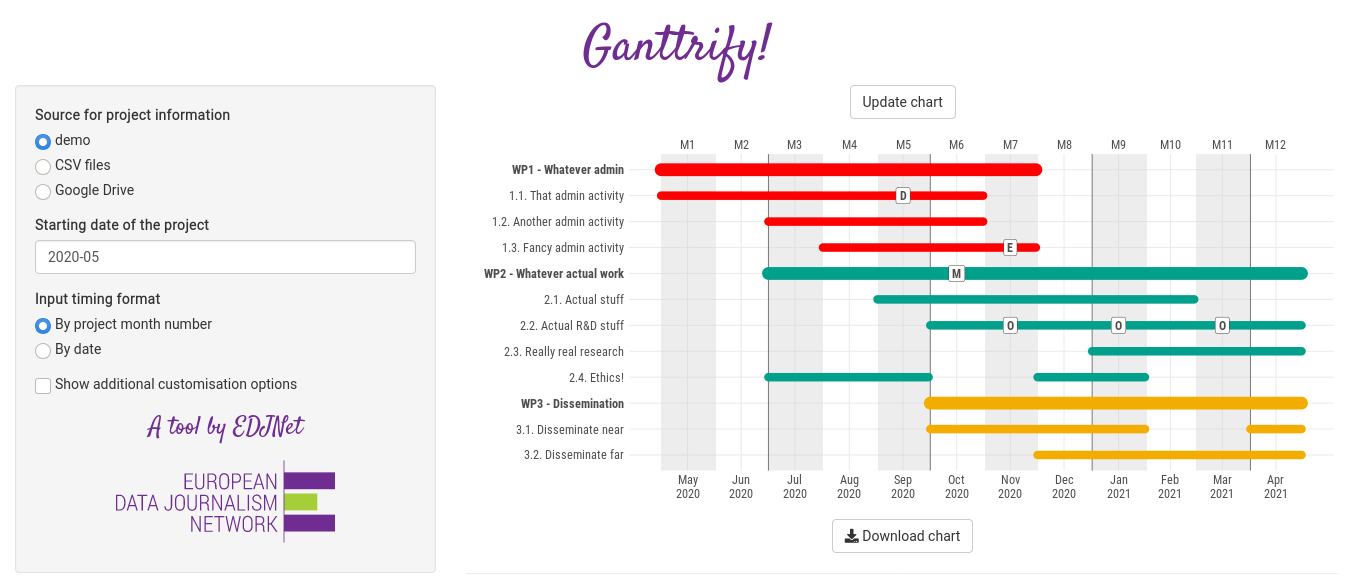
You can check it online with no further ado at the following link:
https://apps.europeandatajournalism.eu/app/ganttrify
Shiny app on Docker
Alright, you don’t know like R, but you know how Docker works?
This is all you need to find yourself a nice web app on localhost
docker run -p 80:80 giocomai/ganttrify
You can of course build yourself the docker image using the Dockerfile
included in this repo.
Additional input formats
Alright, you prefer to use dates rather than month numbers from the
beginning of the project. You’re welcome: just format the date as
follows, and remember to include the month_number = FALSE parameter.
You can also use exact dates (e.g. 2021-01-01), but by default they
would still be converted to include the entire month were that given day
falls.
knitr::kable(ganttrify::test_project_date_month)
| wp | activity | start_date | end_date |
|---|---|---|---|
| WP1 - Whatever admin | 1.1. That admin activity | 2021-01 | 2021-06 |
| WP1 - Whatever admin | 1.2. Another admin activity | 2021-03 | 2021-06 |
| WP1 - Whatever admin | 1.3. Fancy admin activity | 2021-04 | 2021-07 |
| WP2 - Whatever actual work | 2.1. Actual stuff | 2021-05 | 2021-10 |
| WP2 - Whatever actual work | 2.2. Actual R&D stuff | 2021-06 | 2021-12 |
| WP2 - Whatever actual work | 2.3. Really real research | 2021-09 | 2021-12 |
| WP2 - Whatever actual work | 2.4. Ethics! | 2021-03 | 2021-05 |
| WP2 - Whatever actual work | 2.4. Ethics! | 2021-08 | 2021-09 |
| WP3 - Dissemination | 3.1. Disseminate near | 2021-06 | 2021-09 |
| WP3 - Dissemination | 3.1. Disseminate near | 2021-12 | 2021-12 |
| WP3 - Dissemination | 3.2. Disseminate far | 2021-08 | 2021-12 |
ganttrify(project = ganttrify::test_project_date_month,
spots = ganttrify::test_spots_date_month,
by_date = TRUE,
size_text_relative = 1.2,
mark_quarters = TRUE,
font_family = "Roboto Condensed")

As it turns out, someone wants more detail: they’d like to be able to
input activities with an exact start and end date. I start to suspect
that ganttrify at this stage may not be exactly what you’re looking
for, but perhaps this works for you?
knitr::kable(ganttrify::test_project_date_day)
| wp | activity | start_date | end_date |
|---|---|---|---|
| Data team | Data collection | 2020-09-01 | 2020-09-10 |
| Data team | Data processing | 2020-09-08 | 2020-09-14 |
| Data team | Reporting | 2020-09-14 | 2020-09-16 |
| Data team | Data visualisation | 2020-10-23 | 2020-10-30 |
| Investigative team | Fieldwork | 2020-09-05 | 2020-09-15 |
| Investigative team | Fieldwork | 2020-10-10 | 2020-10-20 |
| Investigative team | Writing | 2020-10-21 | 2020-10-31 |
| Social media team | Draft outputs | 2020-10-25 | 2020-10-28 |
| Social media team | Active promo | 2020-10-31 | 2020-12-15 |
ganttrify(project = ganttrify::test_project_date_day,
spots = ganttrify::test_spots_date_day,
by_date = TRUE,
exact_date = TRUE,
size_text_relative = 1.2,
month_number = FALSE,
font_family = "Roboto Condensed")

Troubleshooting
By default, this package uses a generic sans font but it is
recommended to use a narrow (or condensed font such as Roboto
Condensed font - a
free font that can be downloaded and installed on any desktop - as they
make more efficient use of text space.
On Fedora, you can install it with sudo dnf install google-roboto-condensed-fonts
On Debian, you can install it with sudo apt-get install fonts-roboto-fontface
After installation, you should make sure the font is available to R by
installing the extrafont package, and running
extrafont::font_import().
You can check available fonts also with the package systemfonts and
the command systemfonts::system_fonts().
To reduce the number of dependencies, extrafont, as well as the
packages used by the Shiny app needed to import data (googlesheets4,
readxl) and to export the chart in svg (svglite) are only suggested.
You can install them independently (they’re all on CRAN), or together
with this package with:
remotes::install_github("giocomai/ganttrify", dependencies = TRUE)



